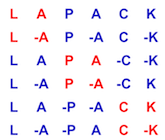 |
LAPACK 3.12.0
LAPACK: Linear Algebra PACKage
|
 |
LAPACK 3.12.0
LAPACK: Linear Algebra PACKage
|
| subroutine dsysv_aa_2stage | ( | character | uplo, |
| integer | n, | ||
| integer | nrhs, | ||
| double precision, dimension( lda, * ) | a, | ||
| integer | lda, | ||
| double precision, dimension( * ) | tb, | ||
| integer | ltb, | ||
| integer, dimension( * ) | ipiv, | ||
| integer, dimension( * ) | ipiv2, | ||
| double precision, dimension( ldb, * ) | b, | ||
| integer | ldb, | ||
| double precision, dimension( * ) | work, | ||
| integer | lwork, | ||
| integer | info | ||
| ) |
DSYSV_AA_2STAGE computes the solution to system of linear equations A * X = B for SY matrices
Download DSYSV_AA_2STAGE + dependencies [TGZ] [ZIP] [TXT]
DSYSV_AA_2STAGE computes the solution to a real system of
linear equations
A * X = B,
where A is an N-by-N symmetric matrix and X and B are N-by-NRHS
matrices.
Aasen's 2-stage algorithm is used to factor A as
A = U**T * T * U, if UPLO = 'U', or
A = L * T * L**T, if UPLO = 'L',
where U (or L) is a product of permutation and unit upper (lower)
triangular matrices, and T is symmetric and band. The matrix T is
then LU-factored with partial pivoting. The factored form of A
is then used to solve the system of equations A * X = B.
This is the blocked version of the algorithm, calling Level 3 BLAS. | [in] | UPLO | UPLO is CHARACTER*1
= 'U': Upper triangle of A is stored;
= 'L': Lower triangle of A is stored. |
| [in] | N | N is INTEGER
The order of the matrix A. N >= 0. |
| [in] | NRHS | NRHS is INTEGER
The number of right hand sides, i.e., the number of columns
of the matrix B. NRHS >= 0. |
| [in,out] | A | A is DOUBLE PRECISION array, dimension (LDA,N)
On entry, the symmetric matrix A. If UPLO = 'U', the leading
N-by-N upper triangular part of A contains the upper
triangular part of the matrix A, and the strictly lower
triangular part of A is not referenced. If UPLO = 'L', the
leading N-by-N lower triangular part of A contains the lower
triangular part of the matrix A, and the strictly upper
triangular part of A is not referenced.
On exit, L is stored below (or above) the subdiagonal blocks,
when UPLO is 'L' (or 'U'). |
| [in] | LDA | LDA is INTEGER
The leading dimension of the array A. LDA >= max(1,N). |
| [out] | TB | TB is DOUBLE PRECISION array, dimension (LTB)
On exit, details of the LU factorization of the band matrix. |
| [in] | LTB | LTB is INTEGER
The size of the array TB. LTB >= 4*N, internally
used to select NB such that LTB >= (3*NB+1)*N.
If LTB = -1, then a workspace query is assumed; the
routine only calculates the optimal size of LTB,
returns this value as the first entry of TB, and
no error message related to LTB is issued by XERBLA. |
| [out] | IPIV | IPIV is INTEGER array, dimension (N)
On exit, it contains the details of the interchanges, i.e.,
the row and column k of A were interchanged with the
row and column IPIV(k). |
| [out] | IPIV2 | IPIV2 is INTEGER array, dimension (N)
On exit, it contains the details of the interchanges, i.e.,
the row and column k of T were interchanged with the
row and column IPIV(k). |
| [in,out] | B | B is DOUBLE PRECISION array, dimension (LDB,NRHS)
On entry, the right hand side matrix B.
On exit, the solution matrix X. |
| [in] | LDB | LDB is INTEGER
The leading dimension of the array B. LDB >= max(1,N). |
| [out] | WORK | WORK is DOUBLE PRECISION workspace of size LWORK |
| [in] | LWORK | LWORK is INTEGER
The size of WORK. LWORK >= N, internally used to select NB
such that LWORK >= N*NB.
If LWORK = -1, then a workspace query is assumed; the
routine only calculates the optimal size of the WORK array,
returns this value as the first entry of the WORK array, and
no error message related to LWORK is issued by XERBLA. |
| [out] | INFO | INFO is INTEGER
= 0: successful exit
< 0: if INFO = -i, the i-th argument had an illegal value.
> 0: if INFO = i, band LU factorization failed on i-th column |
Definition at line 185 of file dsysv_aa_2stage.f.